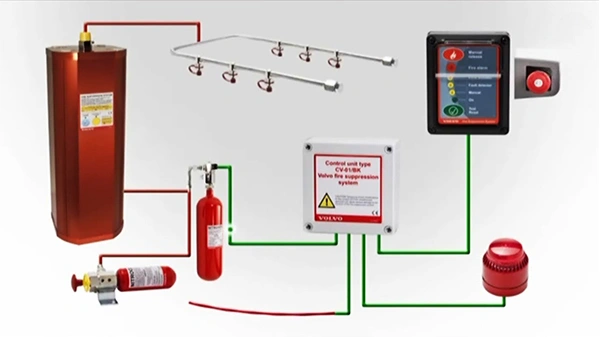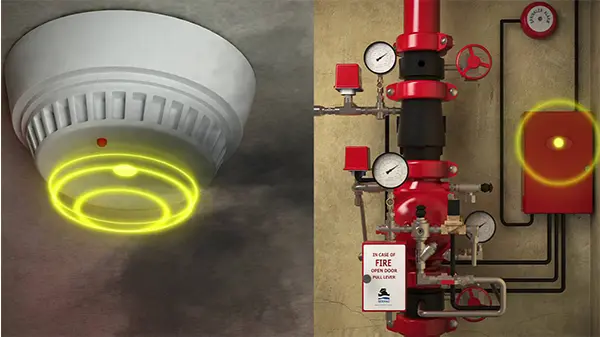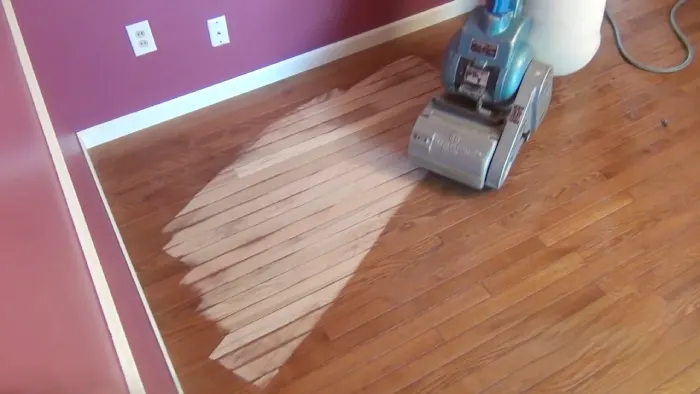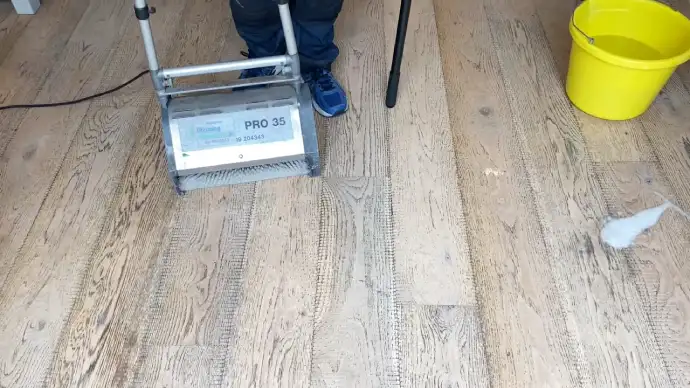The presence of a fire extinguishing system can help to prevent the loss of lives and minimize property loss during a fire. Fire extinguishing systems work by interrupting the chemical reaction that contributes to a fire, thus eliminating the flames quickly and efficiently.
Fire extinguishers come in various types, but the most popular are fire suppression systems & sprinkler systems. Both systems work by releasing agents that interrupt the chemical reaction, but they differ in how they trigger this release.
Consider your facility’s unique requirements when choosing between these two types of fire extinguishers. The system you choose should also be able to suppress a fire effectively.
Please read on to find out the differences between fire suppression and sprinkler systems, their mechanisms for releasing agents, and which method best suits your needs.
Differences Between a Fire Suppression System & a Sprinkler System

It is true that fire suppression systems and fire sprinkler systems both use fire-reducing agents to extinguish the fire. Still, there are some critical differences between the two:
System Working Procedures
Fire suppression systems typically contain a metal cylinder bottle containing CO2, foam, or dry chemicals. When connected to a sprinkler system, these metal cylinder bottles can be activated either manually or by a sensor detector.
Despite its effectiveness, the fire suppression system can only suppress one fire accident at a time because it becomes ineffective after the first use and must be refilled. Often, this can come with a small cylinder bottle that can be activated by the pressure of the user’s hand.
The commercial fire sprinkler system is capable of automatically detecting and putting out fires in their earliest stages as soon as they are detected. This system is usually connected to the building’s water supply and consists of a network of pipes leading to individual sprinkler heads.
When a sprinkler sensor detects a fire, the water is released and sprayed onto the fire, extinguishing it. The amount of water released is determined by the size and type of fire, and it is typically enough to extinguish the flames or prevent them from spreading.
Fire Extinguishing Agents
When it comes to fire suppression agents, various agents can be used to extinguish a blaze. The most common agents are carbon dioxide (CO2), inert gasses (such as Inergen, Argonite, and Nitrogen), foam, and dry chemicals.
Each type of agent has its advantages and disadvantages. CO2 is effective at smothering fires but can be dangerous to people and animals if the area is not well-ventilated.
Inert gasses are safe for people and animals, but they can be quite costly to use. Dry chemicals are cheaper than inert gasses, but they can be corrosive and cause physical harm to equipment.
A fire sprinkler system basically works by releasing water mist into the air and flowing down in the form of drops. This is the most common fire extinction technique used today to extinguish fires because it is very effective and safe for humans and properties.
System Maintenance
Compared to fire suppression systems, the fire sprinkler dry pipe system requires less maintenance. The main reason is that a fire suppression system uses refillable metal cylinder bottles, which must be routinely refilled and replaced after expended.
Also, since fire sprinklers utilize an automatic detection and extinguishing mechanism, there is no need to activate them when a fire occurs manually. This means that there is no risk of human error, and the system will always operate correctly without fail.
But it would be best to regularly clean the sprinkler head and valve as they can face corrosion and other issues.
System Repair Cost
In most cases, fire sprinkler systems are relatively inexpensive to repair or replace. This is because the system comprises only pipes and valves so that no complicated electronics can get damaged. Your sprinkler system will be up and running again once you replace the sprinkler head or sprinkler valve.
Fire suppression systems may become empty during a fire and require extensive refilling to remain functional. This means fire suppression systems often cost more to repair and maintain than fire sprinkler systems.
Yet, a reliable fire suppression system may be worthwhile for extensive, high-value facilities such as hospitals or data centers.
What are the Primary Methods of Fire Suppression & Sprinkler Systems?

Fire suppression and sprinkler systems extinguished the fire using four primary methods. They are water, foam, dry powder, and CO2. Each method has its own advantages and disadvantages.
Water is the most common type of extinguisher. It works by cooling the fuel and stopping the chemical reaction that is taking place. But, it is only effective on some types of fires. Water should not be used on electrical fires or fires involving flammable liquids, as it can spread the flames or cause an electrical shock.
Foam extinguishers smother the fire and prevent oxygen from reaching the fuel. They use a stream of pressurized foam to smother the fire and prevent it from spreading. These extinguishers are generally considered more effective than other types, such as dry chemicals, due to their ability to cool burning liquids quickly.
Dry powder extinguishers work by interrupting chemical reactions. They are one type that can be used on fires involving electrical equipment, combustible metals, and trash cans. They work by smothering the fire and cutting off its oxygen supply.
CO2 extinguishers work by displacing oxygen and interrupting the chemical reaction. They control small fires in electrical equipment and are effective at flammable liquid fires, as the gas does not conduct electricity and therefore presents no risk of electrocution.
Where a Fire Suppression System is Effective?

Fire suppression systems are typically installed in areas with high fire risks, such as restaurant kitchens, chemical factories, industrial facilities, and warehouses. This fire protection system effectively suppresses large fires by eliminating heat sources before they have a chance to grow.
Regardless, some handheld small fire suppression cylinders can help extinguish small fires in your home or office. These systems work by dispersing a fire-fighting agent quickly and effectively, preventing a fire from spreading.
How Often Should a Fire Suppression System be Serviced?
Like all safety equipment, fire suppression systems require regular maintenance. Most experts recommend that fire suppression systems be serviced at least once every 12 months.
This allows technicians to inspect all components and make any necessary repairs. Servicing also allows for the replenishment of fire suppression agent levels, ensuring the system is ready to activate at a moment’s notice.
Is a CO2-Based Fire Suppression System Appropriate for a Data Center?
A Carbon dioxide-based fire suppression system uses carbon dioxide to extinguish fires. When the system is activated, the CO2 is released into the data center server room, displacing oxygen and suffocating the fire.
CO2 is an effective fire suppressant for several reasons. It is non-conductive, so it will not destroy sensitive electronic equipment.
The CO2-based fire-eliminating system does not leave behind any residue, so there is no need to clean up after a discharge. But, carbon dioxide-powered systems do have some drawbacks.
They are more expensive than other types of fire suppression systems, and they require more frequent maintenance. Also, CO2 can be dangerous to people if not properly vented from the room.
What are the Limitations of Fire Suppression Systems?
Even though fire suppression systems are designed to control or extinguish fires, several limitations exist.
- One limitation of fire suppression systems can be less effective in certain types of fires. For example, a fire suppression system may not be able to extinguish a deep-seated or smoldering fire.
- Another limitation is that some fire suppression systems require a water connection. This means that they may not be able to operate in areas where the water supply is limited or nonexistent.
- Plus, automatic fire suppression systems can be expensive to install and maintain. This is often a deterrent for businesses and homeowners on a tight budget.
While fire suppression systems have limitations, they can still be an essential part of protecting people and property from fires.
Where is a Fire Sprinkler System Appropriate?

Sprinkler system’s fire protections are designed to automatically detect and extinguish fires at their earliest stages, minimizing damage and giving occupants time to evacuate. They are installed in ceilings or walls and connected to a water supply so that they can activate automatically when a fire is detected.
These systems are most commonly found in commercial and industrial buildings, but residential properties may use them. Buildings containing sensitive equipment, such as non-expendable property, may benefit from installing a fire sprinkler system. Because the system prevents fire spread and reduces property loss.
Does a Fire Sprinkler System Have Any Advantages Over a Fire Suppression System?
Fire sprinkler dry pipe systems have a few advantages over fire suppression systems:
- They’re more effective at putting out fires. This is because the water from the sprinklers is distributed evenly throughout the room, and it’s under high pressure so that it can penetrate deep into the fire.
- Fire sprinkler systems are less likely to cause damage to the property. This is because the water is only released when there’s a fire, so it’s not sitting in the pipes and causing corrosion.
- These fire extinguishing systems are less expensive to maintain than fire suppression systems because they don’t require as much work to keep them operational.
So, sprinkler systems fire protection can be a suitable choice if you’re seeking an efficient and effective fire safety system instead of a fire suppression system.
Why is it Beneficial for Residential Areas to Have Fire Sprinkler Systems?
Fire sprinkler systems are one of the most effective ways to prevent fire destruction in residential areas. According to the National Fire Protection Association, homes with fire sprinklers are up to 71% less likely to experience fire catastrophes than those without.
Fire sprinkler systems are also required in residential areas for several reasons:
- Fire sprinklers can help control the spread of fires by quickly delivering a large amount of water to the fire site. Performing this action may assist in extinguishing the fire before it spreads further.
- The use of a fire extinguisher will help reduce the smoke and heat produced by a fire. Residents would be able to evacuate more safely due to this improved visibility.
- They can help reduce the water damage caused by firefighters fighting a fire. Because sprinklers direct water away from non-incendiary areas, less water is required to extinguish the fire.
Overall, installing a sprinkler fire system in a residential area can provide significant benefits in terms of safety, property protection, and water conservation.
What are the Drawbacks of Fire Sprinkler Systems?
A sprinkler fire system has several advantages, but there are some limitations to consider when installing one:
- A major concern is water availability. Depending on the building, installing special pumps or tanks may be required to provide sufficient pressure for fire sprinklers.
- The system must be maintained after each trigger event by replacing certain components, refilling storage tanks, and installing additional technology.
- The pipes and components used in fire sprinkler systems are larger than those used in other fire suppression systems. Due to this, some applications may not be suitable for them.
- Considering the cost of the project is essential too. Although sprinklers can save lives and property, they can be expensive to install, particularly in older buildings.
Despite these limitations, fire sprinklers remain the most effective option for preventing fire damage in any residential area.
Fire Suppression or Sprinkler System: Which Fire Extinguishing System You Need?

Your choice of fire-fighting system will depend on your specific needs and concerns, even though both suppression and sprinkler systems can provide valuable fire protection benefits.
An automatic fire suppression system makes sense if you have a high-rise building with a complicated layout. The systems deliver suppression agents directly to the fire’s spot using a network of pipes and nozzles. Since fire suppression systems cost a lot to install and maintain, regular testing is needed to ensure they work.
A sprinkler system’s fire protection may be enough, depending on your building’s size and layout. These systems rely on strategically placed sprinklers to douse a fire with water.
Even though this can cause minor water damage, it is usually less extensive than the devastation caused by an unattended fire. This makes them a popular choice for commercial buildings.
Ultimately, deciding which type of system to install is a matter of personal preference and need. A fire suppression system may be the most appropriate choice if you want the most comprehensive protection possible. If you want a less expensive and easier option, a sprinkler fire system may be appropriate.






